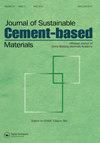Study of 3D printed concrete with low-carbon cementitious materials based on its rheological properties and mechanical performances
IF 4.2
3区 工程技术
Q1 CONSTRUCTION & BUILDING TECHNOLOGY
Journal of Sustainable Cement-Based Materials
Pub Date : 2023-03-24
DOI:10.1080/21650373.2023.2189172
引用次数: 1
Abstract
Using high-volume cement in 3D printed concrete (3DPC) can lead to later crack formation. Accordingly, mineral admixtures can be used as cement replacements to mitigate this disadvantage. In this study, fly ash, slag, and a type of silica fume (with a high water consumption) are selected as supplementary materials in 3DPC under different substitution rates. A method for the printability evaluation of each test group in the orthogonal experiment is proposed based on a comprehensive analysis of the rheological behavior and mechanical performance of the test samples. The results indicate that a cement replacement ratio of 50% can be achieved in 3DPC while retaining its rheological behavior and mechanical performance. According to the actual printing test, the selected silica fume improves the buildability of 3DPC and can serve as an economical and effective cement substitute. The findings in this study also reveal the potential application of poor-quality mineral admixtures in 3DPC, which can increase economy and reduce CO2 emissions.基于流变性能和力学性能的低碳胶凝材料3D打印混凝土研究
在3D打印混凝土(3DPC)中使用大量水泥会导致后期裂缝的形成。因此,矿物掺合料可用作水泥替代品来减轻这一缺点。本研究选择粉煤灰、矿渣和一种高耗水量的硅灰在不同取代率下作为3DPC的补充材料。在综合分析试样流变特性和力学性能的基础上,提出了正交试验中各试验组可印刷性评价方法。结果表明,在保持3DPC流变特性和力学性能的前提下,可实现50%的水泥替代率。通过实际打印试验,所选用的硅灰提高了3d打印材料的可建造性,可以作为一种经济有效的水泥替代品。本研究结果还揭示了劣质矿物掺合料在3DPC中的潜在应用,可以提高经济性并减少CO2排放。
本文章由计算机程序翻译,如有差异,请以英文原文为准。
求助全文
约1分钟内获得全文
求助全文
来源期刊
CiteScore
6.60
自引率
15.90%
发文量
71
期刊介绍:
The Journal of Sustainable Cement-Based Materials aims to publish theoretical and applied researches on materials, products and structures that incorporate cement. The journal is a forum for discussion of research on manufacture, hydration and performance of cement-based materials; novel experimental techniques; the latest analytical and modelling methods; the examination and the diagnosis of real cement and concrete structures; and the potential for improved cement-based materials. The journal welcomes original research papers, major reviews, rapid communications and selected conference papers. The Journal of Sustainable Cement-Based Materials covers a wide range of topics within its subject category, including but are not limited to: • raw materials and manufacture of cement • mixing, rheology and hydration • admixtures • structural characteristics and performance of cement-based materials • characterisation techniques and modeling • use of fibre in cement based-materials • degradation and repair of cement-based materials • novel testing techniques and applications • waste management

 求助内容:
求助内容: 应助结果提醒方式:
应助结果提醒方式:


